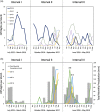Home range, sleeping site use, and band fissioning in hamadryas baboons: Improved estimates using GPS collars
- PMID: 33666273
- PMCID: PMC8244037
- DOI: 10.1002/ajp.23248
Home range, sleeping site use, and band fissioning in hamadryas baboons: Improved estimates using GPS collars
Abstract
Variation in spatial and temporal distribution of resources drives animal movement patterns. Links between ecology and behavior are particularly salient for the multilevel society of hamadryas baboons, in which social units cleave and coalesce over time in response to ecological factors. Here, we used data from GPS collars to estimate home range size and assess temporal patterns of sleeping site use in a band of hamadryas baboons in Awash National Park, Ethiopia. We used GPS data derived from 2 to 3 collared baboons over three 8-12-month collaring intervals to estimate annual and monthly home ranges using kernel density estimators (KDEs) and minimum convex polygons (MCPs). The 95% KDE home range was 64.11 km2 for Collaring Interval I (July 2015-March 2016), 85.52 km2 for Collaring Interval II (October 2016-October 2017), 76.43 km2 for Collaring Interval III (July 2018-May 2019), and 75.25 km2 across all three collaring intervals. MCP home ranges were 103.46 km2 for Collaring Interval I, 97.90 km2 for Collaring Interval II, 105.22 km2 for Collaring Interval III, and 129.33 km2 overall. Ninety-five percent KDE home range sizes did not differ across months, nor correlate with temperature or precipitation, but monthly MCP home ranges increased with monthly precipitation. Our data also revealed a southward home range shift over time and seven previously unknown sleeping sites, three of which were used more often during the wet season. Band cohesion was highest during dry months and lowest during wet months, with fissioning occurring more frequently at higher temperatures. One pair of collared individuals from Collaring Interval III spent 95% of nights together, suggesting they were members of the same clan. Our results both suggest that previous studies have underestimated the home range size of hamadryas baboons and highlight the benefits of remote data collection.
Keywords: fission fusion; home range size; movement patterns; remote sensing; spatial ecology.
© 2021 The Authors. American Journal of Primatology published by Wiley Periodicals LLC.
Figures





Similar articles
-
Ecology and sociality in a multilevel society: ecological determinants of spatial cohesion in hamadryas baboons.Am J Phys Anthropol. 2012 Aug;148(4):580-8. doi: 10.1002/ajpa.22076. Epub 2012 May 3. Am J Phys Anthropol. 2012. PMID: 22552956
-
Use of palm trees as a sleeping site for hamadryas baboons (Papio hamadryas hamadryas) in Ethiopia.Am J Primatol. 2008 Feb;70(2):107-13. doi: 10.1002/ajp.20465. Am J Primatol. 2008. PMID: 17701992
-
Feeding ecology, food availability and ranging patterns of wild hamadryas baboons at Filoha.Folia Primatol (Basel). 2010;81(3):129-45. doi: 10.1159/000316562. Epub 2010 Aug 17. Folia Primatol (Basel). 2010. PMID: 20714160
-
The fourth level of social structure in a multi-level society: ecological and social functions of clans in hamadryas baboons.Am J Primatol. 2009 Nov;71(11):948-55. doi: 10.1002/ajp.20736. Am J Primatol. 2009. PMID: 19670312
-
Review of GPS collar deployments and performance on nonhuman primates.Primates. 2020 May;61(3):373-387. doi: 10.1007/s10329-020-00793-7. Epub 2020 Jan 21. Primates. 2020. PMID: 31965380 Free PMC article. Review.
Cited by
-
Impact of food availability and predator presence on patterns of landscape partitioning among neighbouring Guinea baboon (Papio papio) parties.Mov Ecol. 2025 Feb 22;13(1):9. doi: 10.1186/s40462-025-00534-9. Mov Ecol. 2025. PMID: 39987137 Free PMC article.
-
Spatiotemporal Patterns of Sleeping Site Use of Guinea Baboon Parties (Papio papio).Ecol Evol. 2025 Jul 27;15(7):e71610. doi: 10.1002/ece3.71610. eCollection 2025 Jul. Ecol Evol. 2025. PMID: 40718691 Free PMC article.
-
Comparative ecology of Guinea baboons (Papio papio).Primate Biol. 2021 May 21;8(1):19-35. doi: 10.5194/pb-8-19-2021. eCollection 2021. Primate Biol. 2021. PMID: 34109265 Free PMC article.
References
-
- Abegglen, J. J. (1984). On socialization in hamadryas baboons: A field study. Lewisburg, PA: Bucknell University Press.
-
- Alberts, S. C. , & Altmann, J. (1995). Balancing costs and opportunities: Dispersal in male baboons. The American Naturalist, 145(2), 279–306. 10.1086/285740 - DOI
-
- Alberts, S. C. , & Altmann, J. (2006). The evolutionary past and the research future: Environmental variation and life history flexibility in a primate lineage. In Swedell L., & Leigh S. R. (Eds.), Reproduction and fitness in baboons: Behavioral, ecological, and life history perspectives (pp. 277–303). Springer.
-
- Altmann, S. A. (1974). Baboons, space, time, and energy. American Zoologist, 14(1), 221–248. 10.1093/icb/14.1.221 - DOI
Publication types
MeSH terms
LinkOut - more resources
Full Text Sources
Other Literature Sources
Miscellaneous

